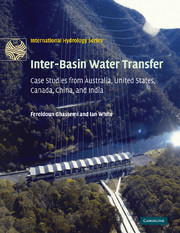Book contents
- Frontmatter
- Contents
- Foreword
- Overview and Scope
- Acknowledgements
- List of Abbreviations
- Part I The Challenges
- Part II Inter-basin Water Transfer in Australia
- Part III Inter-basin Water Transfer in Other Selected Countries
- Part IV Appendices
- Appendix A Some of the Australian pioneers of inter-basin water transfer
- Appendix B Construction timetable of the Snowy Mountains Hydro-electric Scheme
- Appendix C Details of diversion schemes from the Clarence River Basin
- Appendix D Chronological table of the most important events in the Goldfields Pipeline Scheme, Western Australia
- Appendix E Flooding of the Sahara depressions
- Appendix F The Ord River Irrigation Scheme
- Appendix G The West Kimberley Irrigation Scheme
- Appendix H Some other water transfer schemes in Australia
- Appendix I Selected technical features of the Central Valley Project in California
- Appendix J Selected technical features of the State Water Project in California
- Appendix K Selected characteristics of some of the completed or proposed inter-basin water transfer projects in Australia, United States, Canada, China and India, in chronological order
- Glossary
- Index
- References
Appendix E - Flooding of the Sahara depressions
Published online by Cambridge University Press: 05 November 2009
- Frontmatter
- Contents
- Foreword
- Overview and Scope
- Acknowledgements
- List of Abbreviations
- Part I The Challenges
- Part II Inter-basin Water Transfer in Australia
- Part III Inter-basin Water Transfer in Other Selected Countries
- Part IV Appendices
- Appendix A Some of the Australian pioneers of inter-basin water transfer
- Appendix B Construction timetable of the Snowy Mountains Hydro-electric Scheme
- Appendix C Details of diversion schemes from the Clarence River Basin
- Appendix D Chronological table of the most important events in the Goldfields Pipeline Scheme, Western Australia
- Appendix E Flooding of the Sahara depressions
- Appendix F The Ord River Irrigation Scheme
- Appendix G The West Kimberley Irrigation Scheme
- Appendix H Some other water transfer schemes in Australia
- Appendix I Selected technical features of the Central Valley Project in California
- Appendix J Selected technical features of the State Water Project in California
- Appendix K Selected characteristics of some of the completed or proposed inter-basin water transfer projects in Australia, United States, Canada, China and India, in chronological order
- Glossary
- Index
- References
Summary
INTRODUCTION
The idea of flooding the Sahara depressions goes back to the second half of the nineteenth century. The aim was to divert waters of the Mediterranean Sea into the Sahara depressions in Tunisia and Algeria via a canal. The hope was that filling these depressions would alter the climate of the area. The history of the scheme is described in a comprehensive publication by Letolle and Bendjoudi (1997). They describe the geography, geology, hydrology and the socio-economic conditions of the project area. The following brief description is based on their work.
There is a vast depression in the Sahara running from the west of Gabès on the Mediterranean coast of Tunisia to the south-east of Biskra, with a general downward slope of east to west (Figure E.1). Chott Melrhir and Chott Rharsa in the western part of this depression, with an area of about 8000 km2, were proposed for flooding. It was believed that this depression was once part of the ancient Bay of Triton. Herodotus (485–425 bc) and other historians of antiquity described its shores as being highly rich and fertile.
Martins (1864) described that the last of the Chotts in the east is only 16 km away from the sea. By breaking through the Gabès ridge, the basin of the Chotts could become an inland sea. Lavigne (1869) described his observations of the area as a journalist, and raised the possibility of creating an inland sea.
- Type
- Chapter
- Information
- Inter-Basin Water TransferCase Studies from Australia, United States, Canada, China and India, pp. 379 - 383Publisher: Cambridge University PressPrint publication year: 2007



